

Meet & Greet at Keflavík airport with our driver and guide. After just 20 minutes drive we will experience one of the most unusual welcome to any country. We put on our swimming costumes and go bathing in the Blue Lagoon, a natural mineral-rich geothermal pool in the middle of a large and dramatic lava field, reputed for its healing properties. It is special and invigorating. After the bath we will continue our trip to Reykjavik. During the 45 minutes drive the guide will tell you about Iceland and give you a few practical information’s. Arrived in Reykjavik we will check in at our hotel for one night.

We start our journey in a village called Hveragerði (gardens of hot springs), where green house industry is the livelihood of the inhabitants. Vegetable and flowers are grown in these green houses, heated up with natural warm water. We drive on to the Geysir area for a walk around the hot springs The most active geyser is Strokkur “the churn” which can spout up to seventy feet every five to seven minutes We have another wonder waiting us not far from the Geysir area, one of Iceland´s favourite waterfalls named Gullfoss (the golden waterfall). Falling 32 meters into the canyon of Hvítá (the white river) after having travelled 30 km from the glacier Langjökull (the long glacier) in the north. Driving on through the agricultural area of the south, passing the small village of Laugarvatn to drive over a mountain road only used in summer and reach the national park of Þingvellir. Now we have arrived in the a most important historical places of Iceland, the old parliament site, where in the year 930 ac. the national assembly was founded to rule the country. We will take short walk through the old sites trying to find the atmosphere of long gone times. Þingvellir is not only important for Icelandic history, but also it is a place of high geological interest, a place where the meeting of the two drifting continental plates can be seen. We leave Þingvellir and head north, driving along Hvalfjörður (the whale fjord) and arriving in Reykholt where we overnight for one night.

From Reykholt we drive via Holtavörðuheiði to the north of Iceland. We drive pass Vatnsdalshólar, a cluster of hills of all sizes across the mouth of Vatnsdalur valley. These hills are considered to be one of the three “innumerable” things in Iceland along with the lakes in Arnarvatnsheiði and the islands on Breiðarfjörður. We are now in Skagafjörður one of Iceland's most prosperous agricultural regions and especially known for horse breeding and therefore called “valley of horses”. We continue to Akureyri, Iceland's second largest urban area after the http://www.gjtravel.is/media/w700/57598b82b56665f5.jpgGreater Reykjavík area and and often called „the capital of the north”. It boasts of a thriving cultural life, museums, a college, a university and other schools. We will enjoy a city tour before heading to the village Húsavík, where we will stay for two nights. On our way we will visit Goðafoss waterfall. Not only is Goðafoss a stunning waterfall, but it has also played an important role in the history of the country in connection with the introduction of Christianity. The first organized whale watching tours in Iceland started from Húsavík in 1995 and ever since the number of visitors coming to observe these majestic creatures has grown from year to year. The bay of Skjálfandi seems to provide prime conditions for whales.

We will spend all day at Lake Mývatn, a unique area that features strange lava formations, attractive bays, pseudo craters and thousands of birds. Skútustaðargígar where we find numerous pseudo-craters formed over two thousand years ago during one of many eruptions in this area.We stop at Dimmuborgir, Dark Castles, where towering lava formations characterize the surrounding landscape and Námaskarð (mine passage)at a bright colorful mountain where sulphur was once mined from a geothermal zone and where many boiling mud pots are to be found with that special smell of the devils-cuisine. Mývatn area is a paradise for birds, especially ducks which are all to be found breeding in the Lake Mývatn area. During the nesting period however areas around the lake are closed for human access but we will try during our stops to spot some of these numerous birds on our way back to our accommodation.
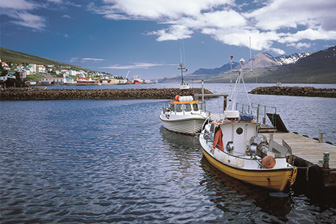
Today we will travel through the east part of Iceland, through bare and sometimes deserted landscape with mountains all around. On the way we will make at least one stop at Möðrudalur, the all-year residence at the highest altitude in Iceland, 469m above sea level. In summertime they run a service centre there, a great place to halt enjoy the view of the queen of Icelandic mountains and visit the church at the farm – home made 1944 by the former farmer in the memory of his late wife. On we go through more fascinated bare landscape also going along the long valley of Jökuldalur (glacial valley) reaching the fertile region of Fljótsdalshérað and onward to south of Iceland, driving on road nr. 1 through green valleys, over mountain roads, along the coast line arriving in Berufjörður, one of many fjords of the east. We drive all around it arriving in the small fishing village Djúpivogur for a short visit before we end our day near Höfn and check in for one night.
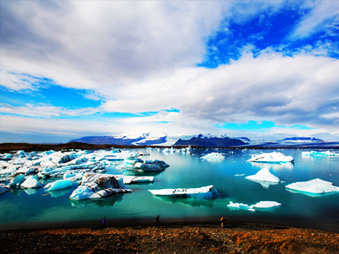
Vatnajökull, Europe´s biggest glacier dominates the landscape. If the weather permits we will be able to enjoy the view of many glacier tongues descending its main ice cap – an amazing contrast to the green fertile areas we drive through. We stop at the glacier lagoon, Jökulsárlón, embark a boat and sail around the floating icebergs of the lagoon. After the boat trip we continue our journey along the south coast with Vatnajökull and also the highest peak in Iceland, 2119m on our right. We will stay for the next two nights in Skaftafell National Park.
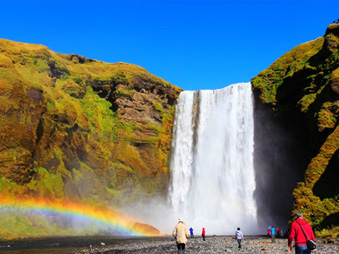
We leave Skaftafell driving over Skeiðarársandur, where the flood of 1996 temporarily cut of this road and some of its bridges, leaving iceberg scattered around the sandy plains and we continue driving through the lava fields of Eldhraun (fire lav) resulted from a yearlong eruption in 1783. This eruption was devastating for Iceland, and the years that followed are referred to as the “misty times” due to the volcanic ash lingering for along time in the air. Passing through the small village of Kirkjubæjarklaustur and driving through the black sands of Mýrdalssandur before arriving in the village of Vík. On we go arriving in Skógar, a tiny village where one of the better http://www.gjtravel.is/media/w700/b84a61838aa91348.JPGFolk Museum can be found with a turf house in the garden and couple of old wooden houses to visit. After we visit the museum we head on to the waterfall of Skógar, fall ing gracefully 60m down the green mountain, a waterfall used more than once as a motive in advertisement. On we go making our last stop at another waterfall called Seljalandsfoss, falling narrowly 50m, possible to see from all sides as we can walk behind it – with care and with the risk of getting wet! From there we drive again through the biggest agricultural area in Iceland, the south low land, before arriving in Reykjavík.
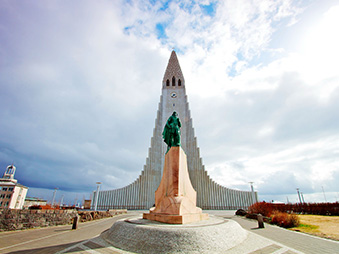
Weaving our ways through narrow alleys framed with old timber houses, we learn about the life of the Icelandic capital from its very beginning to the present day. We pass Hallgrimskirkja-Church and enjoy a photo stop at Höfði house, where the Reagan/Gorbachev summit meeting took place in 1986. From the City Hall we take a walk through the city center to the street where the first settler built his house. Next to the Parliament and Lutheran cathedral we pass the sculpture of Skúli Magnússon, the founder of Reykjavík and Jón Sigurðsson, our real independence hero.
Now we drive to the harbour where we find a large fleet of whale watching and fishing boats in all sizes. We drive past the Catholic Church and enjoy then the panoramic view over Reykjavik, the fjord and mountains from the balcony at the Pearl. We stop at one of the biggest shopping mall in Reykjavik, Kringlan.
We will experience one of the most unusual welcome to any country. We put on our swimming costumes and go bathing in the Blue Lagoon, a natural mineral-rich geothermal pool in the middle of a large and dramatic lava field, reputed for its healing properties. It is special and invigorating.
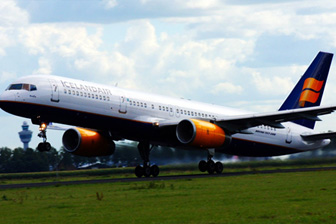
Unfortunately it is time to say goodbye. You will be picked up by a driver and brought to Keflavík International Airport for your departure flight.
Note: We reserve the right to alter routes without prior notice due to road conditions.
summer the climate is mild but unstable with possible rain and frequent weather changes. The daily temperature can fluctuate from a minimum 5 °C at night to a maximum of 25 °C during the day.
CONTACT US | E-mail©2014 ICELANDTRAVEL.COM.CN All Rights Reseved.

WEBCHAT